
Feathered dinosaurs
Encyclopedia
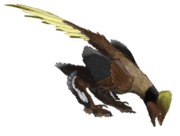
Dinosaur
Dinosaurs are a diverse group of animals of the clade and superorder Dinosauria. They were the dominant terrestrial vertebrates for over 160 million years, from the late Triassic period until the end of the Cretaceous , when the Cretaceous–Paleogene extinction event led to the extinction of...
s are closely related to bird
Bird
Birds are feathered, winged, bipedal, endothermic , egg-laying, vertebrate animals. Around 10,000 living species and 188 families makes them the most speciose class of tetrapod vertebrates. They inhabit ecosystems across the globe, from the Arctic to the Antarctic. Extant birds range in size from...
s raised the obvious possibility of feathered dinosaurs. Fossil
Fossil
Fossils are the preserved remains or traces of animals , plants, and other organisms from the remote past...
s of Archaeopteryx
Archaeopteryx
Archaeopteryx , sometimes referred to by its German name Urvogel , is a genus of theropod dinosaur that is closely related to birds. The name derives from the Ancient Greek meaning "ancient", and , meaning "feather" or "wing"...
include well-preserved feather
Feather
Feathers are one of the epidermal growths that form the distinctive outer covering, or plumage, on birds and some non-avian theropod dinosaurs. They are considered the most complex integumentary structures found in vertebrates, and indeed a premier example of a complex evolutionary novelty. They...
s, but it was not until the early 1990s that clearly non-avialan
Avialae
Avialae is a clade of dinosaurs containing their only living representatives, birds , and the most immediate extinct relatives of birds.-Competing definitions:...
dinosaur fossils were discovered with preserved feathers. Since then, more than twenty genera of dinosaurs, mostly theropods, have been discovered to have been feathered. Most fossils are from the Yixian formation
Yixian Formation
The Yixian Formation is a geological formation in Jinzhou, Liaoning, People's Republic of China, that spans 11 million years during the early Cretaceous period...
in China. The fossil feathers of one specimen, Shuvuuia deserti, have tested positive for beta-keratin
Beta-keratin
β-keratin or beta-keratin is rich in stacked β pleated sheets, in contrast to alpha-keratin, a fibrous protein rich in alpha helices.β-keratin is found in reptiles...
, the main protein in bird feathers, in immunological tests.
Early hypotheses
Shortly after the 1859 publication of Charles DarwinCharles Darwin
Charles Robert Darwin FRS was an English naturalist. He established that all species of life have descended over time from common ancestry, and proposed the scientific theory that this branching pattern of evolution resulted from a process that he called natural selection.He published his theory...
's On the Origin of Species, British biologist
Biologist
A biologist is a scientist devoted to and producing results in biology through the study of life. Typically biologists study organisms and their relationship to their environment. Biologists involved in basic research attempt to discover underlying mechanisms that govern how organisms work...
Thomas Henry Huxley proposed that birds were descendants of dinosaurs. He compared the skeletal structure of Compsognathus
Compsognathus
Compsognathus was a small, bipedal, carnivorous theropod dinosaur. The animal was the size of a turkey and lived around 150 million years ago, the early Tithonian stage of the late Jurassic Period, in what is now Europe. Paleontologists have found two well-preserved fossils, one in Germany...
, a small theropod dinosaur, and the 'first bird' Archaeopteryx lithographica (both of which were found in the Upper Jurassic Bavaria
Bavaria
Bavaria, formally the Free State of Bavaria is a state of Germany, located in the southeast of Germany. With an area of , it is the largest state by area, forming almost 20% of the total land area of Germany...
n limestone
Limestone
Limestone is a sedimentary rock composed largely of the minerals calcite and aragonite, which are different crystal forms of calcium carbonate . Many limestones are composed from skeletal fragments of marine organisms such as coral or foraminifera....
of Solnhofen
Solnhofen
Solnhofen is a municipality in the district of Weißenburg-Gunzenhausen in the region of Franconia in the Land of Bavaria in Germany. It lies within the Altmühl valley....
). He showed that, apart from its hands and feathers, Archaeopteryx was quite similar to Compsognathus. In 1868 he published On the Animals which are most nearly intermediate between Birds and Reptiles, making the case. The leading dinosaur expert of the time, Richard Owen
Richard Owen
Sir Richard Owen, FRS KCB was an English biologist, comparative anatomist and palaeontologist.Owen is probably best remembered today for coining the word Dinosauria and for his outspoken opposition to Charles Darwin's theory of evolution by natural selection...
, disagreed, claiming Archaeopteryx as the first bird outside dinosaur lineage. For the next century, claims that birds were dinosaur descendants faded, with more popular bird-ancestry hypotheses including 'crocodylomorph' and 'thecodont
Thecodont
Thecodont , now considered an obsolete term, was formerly used to describe a diverse range of early archosaurs that first appeared in the Latest Permian and flourished until the end of the Triassic period...
' ancestors, rather than dinosaurs or other archosaurs.
In 1964, John Ostrom
John Ostrom
John H. Ostrom was an American paleontologist who revolutionized modern understanding of dinosaurs in the 1960s, when he demonstrated that dinosaurs are more like big non-flying birds than they are like lizards , an idea first proposed by Thomas Henry Huxley in the 1860s, but which had garnered...
described Deinonychus antirrhopus, a theropod whose skeletal resemblance to birds seemed unmistakable. Ostrom became a leading proponent of the theory that birds are direct descendants of dinosaurs. Further comparisons of bird and dinosaur skeletons, as well as cladistic analysis
Cladistics
Cladistics is a method of classifying species of organisms into groups called clades, which consist of an ancestor organism and all its descendants . For example, birds, dinosaurs, crocodiles, and all descendants of their most recent common ancestor form a clade...
strengthened the case for the link, particularly for a branch of theropods called maniraptors. Skeletal similarities include the neck
Neck
The neck is the part of the body, on many terrestrial or secondarily aquatic vertebrates, that distinguishes the head from the torso or trunk. The adjective signifying "of the neck" is cervical .-Boner anatomy: The cervical spine:The cervical portion of the human spine comprises seven boney...
, the pubis
Pubis (bone)
In vertebrates, the pubic bone is the ventral and anterior of the three principal bones composing either half of the pelvis.It is covered by a layer of fat, which is covered by the mons pubis....
, the wrist
Wrist
In human anatomy, the wrist is variously defined as 1) the carpus or carpal bones, the complex of eight bones forming the proximal skeletal segment of the hand;...
s (semi-lunate carpal), the 'arm
Arm
In human anatomy, the arm is the part of the upper limb between the shoulder and the elbow joints. In other animals, the term arm can also be used for analogous structures, such as one of the paired forelimbs of a four-legged animal or the arms of cephalopods...
s' and pectoral girdle, the shoulder blade, the clavicle
Clavicle
In human anatomy, the clavicle or collar bone is a long bone of short length that serves as a strut between the scapula and the sternum. It is the only long bone in body that lies horizontally...
and the breast bone. In all, over a hundred distinct anatomical features are shared by birds and theropod dinosaurs.
Other researchers drew on these shared features and other aspects of dinosaur biology and began to suggest that at least some theropod dinosaurs were feathered. The first restoration of a feathered dinosaur was Sarah Landry's depiction of a feathered "Syntarsus" (now renamed Megapnosaurus
Megapnosaurus
Megapnosaurus was a dinosaur of the theropod family Coelophysidae, formerly called Syntarsus , living during the Early Jurassic. It was renamed by American entomologist Dr. Michael Ivie , Polish Australian Dr...
or considered a synonym of Coelophysis
Coelophysis
Coelophysis , meaning "hollow form" in reference to its hollow bones , is one of the earliest known genera of dinosaur...
), in Robert T. Bakker
Robert T. Bakker
Robert T. Bakker is an American paleontologist who helped reshape modern theories about dinosaurs, particularly by adding support to the theory that some dinosaurs were endothermic...
's 1975 publication Dinosaur Renaissance. Gregory S. Paul was probably the first paleoartist to depict maniraptoran dinosaurs with feathers and protofeathers, starting in the late 1970s.
By the 1990s, most paleontologists considered birds to be surviving dinosaurs and referred to 'non-avialan dinosaurs' (all extinct), to distinguish them from birds (Avialae
Avialae
Avialae is a clade of dinosaurs containing their only living representatives, birds , and the most immediate extinct relatives of birds.-Competing definitions:...
). Before the discovery of feathered dinosaurs, the evidence was limited to Huxley and Ostrom's comparative anatomy
Comparative anatomy
Comparative anatomy is the study of similarities and differences in the anatomy of organisms. It is closely related to evolutionary biology and phylogeny .-Description:...
. Some mainstream ornithologists, including Smithsonian Institution
Smithsonian Institution
The Smithsonian Institution is an educational and research institute and associated museum complex, administered and funded by the government of the United States and by funds from its endowment, contributions, and profits from its retail operations, concessions, licensing activities, and magazines...
curator Storrs L. Olson
Storrs L. Olson
Storrs Lovejoy Olson is an American biologist and ornithologist from the Smithsonian Institution. He is one of the world's foremost avian paleontologists....
, disputed the links, specifically citing the lack of fossil evidence for feathered dinosaurs.
Fossil evidence
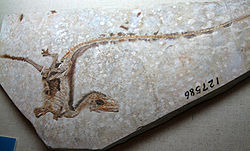
Lagerstätte
A Lagerstätte is a sedimentary deposit that exhibits extraordinary fossil richness or completeness.Palaeontologists distinguish two kinds....
— a sediment
Sediment
Sediment is naturally occurring material that is broken down by processes of weathering and erosion, and is subsequently transported by the action of fluids such as wind, water, or ice, and/or by the force of gravity acting on the particle itself....
ary deposit exhibiting remarkable richness and completeness in its fossils — in Liaoning
Liaoning
' is a province of the People's Republic of China, located in the northeast of the country. Its one-character abbreviation is "辽" , a name taken from the Liao River that flows through the province. "Níng" means "peace"...
, China
China
Chinese civilization may refer to:* China for more general discussion of the country.* Chinese culture* Greater China, the transnational community of ethnic Chinese.* History of China* Sinosphere, the area historically affected by Chinese culture...
. The area had repeatedly been smothered in volcanic ash produced by eruptions in Inner Mongolia
Inner Mongolia
Inner Mongolia is an autonomous region of the People's Republic of China, located in the northern region of the country. Inner Mongolia shares an international border with the countries of Mongolia and the Russian Federation...
124 million years ago, during the Early Cretaceous
Cretaceous
The Cretaceous , derived from the Latin "creta" , usually abbreviated K for its German translation Kreide , is a geologic period and system from circa to million years ago. In the geologic timescale, the Cretaceous follows the Jurassic period and is followed by the Paleogene period of the...
Period. The fine-grained ash preserved the living organisms that it buried in fine detail. The area was teeming with life, with millions of leaves, angiosperms (the oldest known), insect
Insect
Insects are a class of living creatures within the arthropods that have a chitinous exoskeleton, a three-part body , three pairs of jointed legs, compound eyes, and two antennae...
s, fish
Fish
Fish are a paraphyletic group of organisms that consist of all gill-bearing aquatic vertebrate animals that lack limbs with digits. Included in this definition are the living hagfish, lampreys, and cartilaginous and bony fish, as well as various extinct related groups...
, frog
Frog
Frogs are amphibians in the order Anura , formerly referred to as Salientia . Most frogs are characterized by a short body, webbed digits , protruding eyes and the absence of a tail...
s, salamander
Salamander
Salamander is a common name of approximately 500 species of amphibians. They are typically characterized by a superficially lizard-like appearance, with their slender bodies, short noses, and long tails. All known fossils and extinct species fall under the order Caudata, while sometimes the extant...
s, mammal
Mammal
Mammals are members of a class of air-breathing vertebrate animals characterised by the possession of endothermy, hair, three middle ear bones, and mammary glands functional in mothers with young...
s, turtle
Turtle
Turtles are reptiles of the order Testudines , characterised by a special bony or cartilaginous shell developed from their ribs that acts as a shield...
s, lizard
Lizard
Lizards are a widespread group of squamate reptiles, with nearly 3800 species, ranging across all continents except Antarctica as well as most oceanic island chains...
s and crocodilia
Crocodilia
Crocodilia is an order of large reptiles that appeared about 84 million years ago in the late Cretaceous Period . They are the closest living relatives of birds, as the two groups are the only known survivors of the Archosauria...
ns discovered to date.
The most important discoveries at Liaoning have been a host of feathered dinosaur fossils, with a steady stream of new finds filling in the picture of the dinosaur-bird connection and adding more to theories of the evolutionary development of feathers and flight. Norell et al. (2007) reported quill knobs from an ulna of Velociraptor mongoliensis, and these are strongly correlated with large and well-developed secondary feathers.
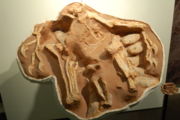
Bird
Birds are feathered, winged, bipedal, endothermic , egg-laying, vertebrate animals. Around 10,000 living species and 188 families makes them the most speciose class of tetrapod vertebrates. They inhabit ecosystems across the globe, from the Arctic to the Antarctic. Extant birds range in size from...
s. Its forearms were folded, like those of a bird
Bird
Birds are feathered, winged, bipedal, endothermic , egg-laying, vertebrate animals. Around 10,000 living species and 188 families makes them the most speciose class of tetrapod vertebrates. They inhabit ecosystems across the globe, from the Arctic to the Antarctic. Extant birds range in size from...
. Although no feather
Feather
Feathers are one of the epidermal growths that form the distinctive outer covering, or plumage, on birds and some non-avian theropod dinosaurs. They are considered the most complex integumentary structures found in vertebrates, and indeed a premier example of a complex evolutionary novelty. They...
s were preserved, it is likely that these would have been present to insulate eggs and juveniles.
Genuine feathers?
There have been claims that the supposed feathers of the Chinese fossils were a preservation artifact. Despite doubts, the fossil feathers have roughly the same appearance as those of birds fossilized in the same locality, so there is no serious reason to think they are of different nature; moreover, no non-theropod fossil from the same site shows such an artifact, but sometimes show unambiguous hair (some mammals) or scales (some reptiles).The "Archaeoraptor" fake
In 1999, a supposed 'missing link' fossil of an apparently feathered dinosaur named "Archaeoraptor liaoningensisArchaeoraptor
"Archaeoraptor" is the generic name informally assigned in 1999 to a fossil from China in an article published in National Geographic magazine. The magazine claimed that the fossil was a "missing link" between birds and terrestrial theropod dinosaurs. Even prior to this publication there had been...
", found in Liaoning Province, northeastern China
China
Chinese civilization may refer to:* China for more general discussion of the country.* Chinese culture* Greater China, the transnational community of ethnic Chinese.* History of China* Sinosphere, the area historically affected by Chinese culture...
, turned out to be a forgery. Comparing the photograph of the specimen with another find, Chinese paleontologist Xu Xing came to the conclusion that it was composed of two portions of different fossil animals. His claim made National Geographic review their research and they too came to the same conclusion. The bottom portion of the "Archaeoraptor" composite came from a legitimate feathered dromaeosaurid now known as Microraptor
Microraptor
Microraptor is a genus of small, four-winged dromaeosaurid dinosaurs. Numerous well-preserved fossil specimens have been recovered from Liaoning, China...
, and the upper portion from a previously-known primitive bird called Yanornis
Yanornis
Yanornis is an extinct genus of omnivorous Early Cretaceous birds, thought to be closely related to the common ancestor of all modern birds. One species, Yanornis martini,...
.
Evidence in amber
In 2011, samples of amberAmber
Amber is fossilized tree resin , which has been appreciated for its color and natural beauty since Neolithic times. Amber is used as an ingredient in perfumes, as a healing agent in folk medicine, and as jewelry. There are five classes of amber, defined on the basis of their chemical constituents...
were discovered to contain preserved feathers from 75 to 80 million years ago during the Cretaceous era, with evidence that they were from both dinosaurs and birds. Initial analysis suggests that some of the feathers were used for insulation, and not flight. More complex feathers were revealed to have variations in coloration similar to modern birds, while simpler protofeathers were predominantly dark. Only 11 specimens are currently known. The specimens are too rare to be broken open to study their melanosome
Melanosome
In a biological cell, a melanosome is an organelle containing melanin, the most common light-absorbing pigment found in the animal kingdom.Cells that synthesize melanins are called melanocytes, and also the retinal pigment epithelium cells, whereas cells that have merely engulfed the melanosomes...
s, but there are plans for using non-destructive high-resolution X-ray imaging.
List of dinosaur genera preserved with evidence of feathers
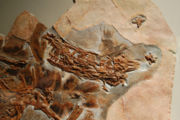
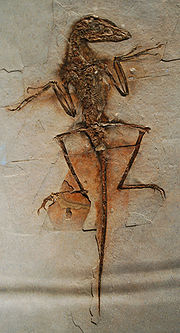
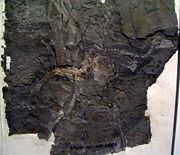
Pygostyle
Pygostyle refers to a number of the final few caudal vertebrae fused into a single ossification, supporting the tail feathers and musculature. In modern birds, the rectrices attach to these....
(the fused vertebrae at the tail tip which often supports large feathers).
- ArchaeopteryxArchaeopteryxArchaeopteryx , sometimes referred to by its German name Urvogel , is a genus of theropod dinosaur that is closely related to birds. The name derives from the Ancient Greek meaning "ancient", and , meaning "feather" or "wing"...
(1861; possibly avialan) - AvimimusAvimimusAvimimus , meaning "bird mimic" , was a genus of bird-like maniraptoran dinosaur that lived in the late Cretaceous in what is now Mongolia, around 70 million years ago.-Description:...
(inferred 1987: quill knobs) - WellnhoferiaWellnhoferiaWellnhoferia is a genus of early prehistoric bird closely related to Archaeopteryx. It lived in what is now Germany, during the Late Jurassic. While Wellnhoferia was similar to Archaeopteryx, it had a shorter tail and its fourth toe was shorter than in Archaeopteryx...
(1988; possibly avialan) - SinosauropteryxSinosauropteryxSinosauropteryx was the first genus of dinosaur outside of Avialae to be found with evidence of feathers. They were covered with "furry" coats of very simple filament-like feathers...
(1996) - ProtarchaeopteryxProtarchaeopteryxProtarchaeopteryx is a genus of turkey-sized feathered theropod dinosaur from China. Known from the Jianshangou bed of the Yixian Formation, it lived during the early Aptian age of the Early Cretaceous, approximately 124.6 million years ago...
(1997) - CaudipteryxCaudipteryxCaudipteryx is a genus of peacock-sized theropod dinosaurs that lived in the Aptian age of the early Cretaceous Period . They were feathered and remarkably birdlike in their overall appearance....
(1998) - RahonavisRahonavisRahonavis is a genus of bird-like dinosaur from the Late Cretaceous of what is now northwestern Madagascar. It is known from a partial skeleton found in Maevarano Formation rocks at a quarry near Berivotra, Mahajanga Province...
(inferred 1998: quill knobs; possibly avialan) - ShuvuuiaShuvuuiaShuvuuia is a genus of bird-like theropod dinosaur from the late Cretaceous period of Mongolia. It is a member of the family Alvarezsauridae, small coelurosaurian dinosaurs which are characterized by short but powerful forelimbs specialized for digging. The type species is Shuvuuia deserti, or...
(1999) - SinornithosaurusSinornithosaurusSinornithosaurus is a genus of feathered dromaeosaurid dinosaur from the early Cretaceous Period of the Yixian Formation in what is now China. It was the fifth non–avian feathered dinosaur genus discovered by 1999...
(1999) - BeipiaosaurusBeipiaosaurusBeipiaosaurus is a genus of therizinosauroid theropod dinosaur from the Early Cretaceous of China.The exact classification of therizinosaurs had in the past been hotly debated, since their prosauropod-like teeth and body structure indicate that they were generally herbivorous, unlike typical...
(1999) - MicroraptorMicroraptorMicroraptor is a genus of small, four-winged dromaeosaurid dinosaurs. Numerous well-preserved fossil specimens have been recovered from Liaoning, China...
(2000) - NomingiaNomingiaNomingia is a genus of oviraptorid theropod dinosaur hailing from the Late Cretaceous Bugin Tsav Beds of Mongolia.-Discovery and naming:...
(inferred 2000: pygostyle) - NGMC 91NGMC 91NGMC 91, nicknamed “Dave”, is an as-yet unnamed, substantially complete, fossil of a small dromaeosaurid dinosaur from the Early Cretaceous Yixian Formation of Liaoning, China. The specimen is in the collection of the National Geological Museum of China. It was collected in Fanzhangzi quarry, near...
(2001) - PsittacosaurusPsittacosaurusPsittacosaurus is a genus of psittacosaurid ceratopsian dinosaur from the Early Cretaceous Period of what is now Asia, about 130 to 100 million years ago. It is notable for being the most species-rich dinosaur genus...
? (2002) - YixianosaurusYixianosaurusYixianosaurus is a maniraptoran theropod dinosaur genus from the Early Cretaceous of China.The type species, Yixianosaurus longimanus, was formally named and described by Xu Xing and Wang Xiaolin in 2003. Its partial skeleton was discovered in 2001, in Liaoning at Wangjiagou in northeastern China....
(2003) - Dilong (2004)
- PedopennaPedopennaPedopenna is a genus of small, feathered, maniraptoran dinosaur from the Daohugou Beds in China. It is possibly older than Archaeopteryx, though the age of the Daohugou Beds where it was found is debated...
(2005; possibly avialan) - JinfengopteryxJinfengopteryxJinfengopteryx is a genus of maniraptoran dinosaur. It was found in the Qiaotou member of the Huajiying Formation of Hebei Province, China, and is therefore of uncertain age...
(2005) - JuravenatorJuravenatorJuravenator is a genus of small coelurosaurian dinosaur, which lived in the area which would someday become the Jura mountains of Germany, about 151 or 152 million years ago. It is known from a single, juvenile specimen...
(2006) - SinocalliopteryxSinocalliopteryxSinocalliopteryx is a genus of compsognathid dinosaur from the Lower Cretaceous Yixian Formation of China...
(2007) - VelociraptorVelociraptorVelociraptor is a genus of dromaeosaurid theropod dinosaur that existed approximately 75 to 71 million years ago during the later part of the Cretaceous Period. Two species are currently recognized, although others have been assigned in the past. The type species is V. mongoliensis; fossils...
(inferred 2007: quill knobs) - SimilicaudipteryxSimilicaudipteryxSimilicaudipteryx, meaning "similar to Caudipteryx" , is a genus of theropod dinosaur of the family Caudipteridae. Its fossil remains were recovered from the Jiufotang and Yixian Formations of northeastern China, dating to the early Cretaceous Period between 124 and 120 million years ago...
(inferred 2008: pygostyle; confirmed 2010) - AnchiornisAnchiornisAnchiornis is a genus of small, feathered, deinonychosaurian dinosaur. The genus Anchiornis contains the type species Anchiornis huxleyi, named in honor of Thomas Henry Huxley, an early proponent of biological evolution, and the first to propose a close evolutionary relationship between birds and...
(2009) - TianyulongTianyulongTianyulong is a genus of heterodontosaurid ornithischian dinosaur. The only species is T. confuciusi, whose remains were discovered in Jianchang County, Western Liaoning Province, China...
? (2009) - ConcavenatorConcavenatorConcavenator is a genus of theropod dinosaur that lived approximately 130 million years ago during the early Cretaceous period . The type species is C. corcovatus; Concavenator corcovatus means "hump backed hunter from Cuenca"...
? (inferred 2010: quill knobs?) - XiaotingiaXiaotingiaXiaotingia is a genus of bird-like theropod dinosaur from early Late Jurassic deposits of western Liaoning, China, containing a single species, Xiaotingia zhengi.-Discovery:...
(2011)
- The ornithmomimosaur PelecanimimusPelecanimimusPelecanimimus is a genus of basal ornithomimosaurian theropod dinosaur from the Early Cretaceous of Spain...
was initially reported to preserve filamentous feathers. However, subsequent detailed study of the structure showed them to be muscle fibers.
- Note, filamentous structures in some ornithischiaOrnithischiaOrnithischia or Predentata is an extinct order of beaked, herbivorous dinosaurs. The name ornithischia is derived from the Greek ornitheos meaning 'of a bird' and ischion meaning 'hip joint'...
n dinosaurs (Psittacosaurus, Tianyulong) and pterosaurs may or may not be homologousHomology (biology)Homology forms the basis of organization for comparative biology. In 1843, Richard Owen defined homology as "the same organ in different animals under every variety of form and function". Organs as different as a bat's wing, a seal's flipper, a cat's paw and a human hand have a common underlying...
with the feathers and protofeathers of theropods.
Primitive feather types
Integumentary structures that gave rise to the feathers of birds are seen in the dorsal spines of reptiles and fish. A similar stage in their evolution to the complex coats of birds and mammals can be observed in living reptiles such as IguanaIguana
Iguana is a herbivorous genus of lizard native to tropical areas of Central America and the Caribbean. The genus was first described in 1768 by Austrian naturalist Josephus Nicolaus Laurenti in his book Specimen Medicum, Exhibens Synopsin Reptilium Emendatam cum Experimentis circa Venena...
s and Gonocephalus
Gonocephalus
-Classification of genus Gonocephalus:*Gonocephalus bellii*Gonocephalus beyschlagi*Gonocephalus borneensis*Gonocephalus boydii ?*Gonocephalus chamaeleontinus*Gonocephalus doriae*Gonocephalus grandis...
Agamids. Feather structures are thought to have proceeded from simple hollow filaments through several stages of increasing complexity, ending with the large, deeply rooted, feathers with strong pens (rachis
Rachis
Rachis is a biological term for a main axis or "shaft".-In zoology:In vertebrates a rachis can refer to the series of articulated vertebrae, which encase the spinal cord. In this case the rachis usually form the supporting axis of the body and is then called the spine or vertebral column...
), barbs and barbules that birds display today.
Some evidence suggests that the original function of simple feathers was insulation. In particular, preserved patches of skin in large, derived, tyrannosauroids show scutes, while those in smaller, more primitive, forms show feathers. This may indicate that the larger forms had complex skins, with both scutes and filaments, or that tyrannosauroids may be like rhinos and elephants, having filaments at birth and then losing them as they developed to maturity. An adult Tyrannosaurus rex weighed about as much as an African Elephant. If large tyrannosauroids were endothermic
Endothermic
In thermodynamics, the word endothermic describes a process or reaction in which the system absorbs energy from the surroundings in the form of heat. Its etymology stems from the prefix endo- and the Greek word thermasi,...
, they would have needed to radiate heat efficiently, and feathers would have interfered with this.
The fact that precursors of feathers appeared and then were co-opted for insulation is already present in Gould and Vrba, 1982. The reason why such precursors appeared could be explained by a theory which is based on metabolic issue. Feathers are made of protein and contain substantial amounts of certain amino acids, especially cysteine. The protein complex at the base of the composition of the feather is keratin, which has disulfide bonds between amino acids that confer unique properties of stability and elasticity. The metabolism of amino acids containing sulfur proteins proved to be toxic to the organism. If the sulfur amino acids are not catabolized at the final products of urea or uric acid but used for the synthesis of keratin instead, the release of hydrogen sulfide is extremely reduced or avoided. For an organism whose metabolism works at high internal temperatures of 40 °C or greater can be extremely important to prevent the excess production of hydrogen sulfide. This hypothesis could be consistent with the need for high metabolic rate of theropod dinosaurs.
It is not known with certainty at what point in archosaur
Archosaur
Archosaurs are a group of diapsid amniotes whose living representatives consist of modern birds and crocodilians. This group also includes all extinct non-avian dinosaurs, many extinct crocodilian relatives, and pterosaurs. Archosauria, the archosaur clade, is a crown group that includes the most...
phylogeny
Phylogenetics
In biology, phylogenetics is the study of evolutionary relatedness among groups of organisms , which is discovered through molecular sequencing data and morphological data matrices...
the earliest simple “protofeathers” arose, or if they arose once or, independently, multiple times. Filamentous structures are clearly present in pterosaurs, and long, hollow quills have been reported in specimens of the ornithischia
Ornithischia
Ornithischia or Predentata is an extinct order of beaked, herbivorous dinosaurs. The name ornithischia is derived from the Greek ornitheos meaning 'of a bird' and ischion meaning 'hip joint'...
n dinosaurs Psittacosaurus
Psittacosaurus
Psittacosaurus is a genus of psittacosaurid ceratopsian dinosaur from the Early Cretaceous Period of what is now Asia, about 130 to 100 million years ago. It is notable for being the most species-rich dinosaur genus...
and Tianyulong
Tianyulong
Tianyulong is a genus of heterodontosaurid ornithischian dinosaur. The only species is T. confuciusi, whose remains were discovered in Jianchang County, Western Liaoning Province, China...
. In 2009 Xu et al. noted that the hollow, unbranched, stiff integumentary structures found on a specimen of Beipiaosaurus
Beipiaosaurus
Beipiaosaurus is a genus of therizinosauroid theropod dinosaur from the Early Cretaceous of China.The exact classification of therizinosaurs had in the past been hotly debated, since their prosauropod-like teeth and body structure indicate that they were generally herbivorous, unlike typical...
were strikingly similar to the integumentary structures of psittacosaurus
Psittacosaurus
Psittacosaurus is a genus of psittacosaurid ceratopsian dinosaur from the Early Cretaceous Period of what is now Asia, about 130 to 100 million years ago. It is notable for being the most species-rich dinosaur genus...
and pterosaur
Pterosaur
Pterosaurs were flying reptiles of the clade or order Pterosauria. They existed from the late Triassic to the end of the Cretaceous Period . Pterosaurs are the earliest vertebrates known to have evolved powered flight...
s. They suggested that all of these structures may have been inherited from a common ancestor much earlier in the evolution of archosaur
Archosaur
Archosaurs are a group of diapsid amniotes whose living representatives consist of modern birds and crocodilians. This group also includes all extinct non-avian dinosaurs, many extinct crocodilian relatives, and pterosaurs. Archosauria, the archosaur clade, is a crown group that includes the most...
s, possibly in an ornithodire from the Middle Triassic
Triassic
The Triassic is a geologic period and system that extends from about 250 to 200 Mya . As the first period of the Mesozoic Era, the Triassic follows the Permian and is followed by the Jurassic. Both the start and end of the Triassic are marked by major extinction events...
or earlier.
Display feathers are also known from dinosaurs that are very primitive members of the bird lineage, or Avialae
Avialae
Avialae is a clade of dinosaurs containing their only living representatives, birds , and the most immediate extinct relatives of birds.-Competing definitions:...
. The most primitive example is Epidexipteryx
Epidexipteryx
Epidexipteryx is a genus of small avialan dinosaur, known from one fossil specimen in the collection of the Institute of Vertebrate Paleontology and Paleoanthropology in Beijing. Epidexipteryx represents the earliest known example of ornamental feathers in the fossil record. The type specimen is...
, which had a short tail with extremely long, ribbon - like, feathers. Oddly enough, the fossil does not preserve wing feathers, suggesting that Epidexipteryx was either secondarily flightless, or that display feathers evolved before flight feathers in the bird lineage.
Phylogeny and the inference of feathers in other dinosaurs
Fossil feather impressions are extremely rare and they require exceptional preservation conditions to form. Therefore only a few feathered dinosaur generaGenera
Genera is a commercial operating system and development environment for Lisp machines developed by Symbolics. It is essentially a fork of an earlier operating system originating on the MIT AI Lab's Lisp machines which Symbolics had used in common with LMI and Texas Instruments...
have been identified so far. However, through a process called phylogenetic bracketing
Phylogenetic bracketing
Phylogenetic bracketing is a method of inference used in biological sciences. It is to infer the likelihood of unknown traits in organisms based on their position in a phylogenetic tree. One of the main applications of phylogenetic bracketing is on extinct animals, known only from fossils...
, scientists can infer the presence of feathers on poorly-preserved specimens. All fossil feather specimens have been found to show certain similarities. Due to these similarities and through developmental research almost all scientists agree that feathers could only have evolved once in dinosaurs. Feathers would then have been passed down to all later, more derived species (although it is possible that some lineages lost feathers secondarily). If a dinosaur falls at a point on an evolutionary tree within the known feather-bearing lineages, scientists assume it too had feathers, unless conflicting evidence is found. This technique can also be used to infer the type of feathers a species may have had, since the developmental history of feathers is now reasonably well-known.
The scientists who described the (apparently unfeathered) Juravenator
Juravenator
Juravenator is a genus of small coelurosaurian dinosaur, which lived in the area which would someday become the Jura mountains of Germany, about 151 or 152 million years ago. It is known from a single, juvenile specimen...
performed a genealogical study
Cladistics
Cladistics is a method of classifying species of organisms into groups called clades, which consist of an ancestor organism and all its descendants . For example, birds, dinosaurs, crocodiles, and all descendants of their most recent common ancestor form a clade...
of coelurosaurs, including distribution of various feather types. Based on the placement of feathered species in relation to those that have not been found with any type of skin impressions, they were able to infer the presence of feathers in certain dinosaur groups. The following simplified cladogram
Cladogram
A cladogram is a diagram used in cladistics which shows ancestral relations between organisms, to represent the evolutionary tree of life. Although traditionally such cladograms were generated largely on the basis of morphological characters, DNA and RNA sequencing data and computational...
follows these results, and shows the likely distribution of plumaceous (downy) and pennaceous (vaned) feathers among theropods. Note that the authors inferred pennaceous feathers for Velociraptor
Velociraptor
Velociraptor is a genus of dromaeosaurid theropod dinosaur that existed approximately 75 to 71 million years ago during the later part of the Cretaceous Period. Two species are currently recognized, although others have been assigned in the past. The type species is V. mongoliensis; fossils...
based on phylogenetic bracketing
Phylogenetic bracketing
Phylogenetic bracketing is a method of inference used in biological sciences. It is to infer the likelihood of unknown traits in organisms based on their position in a phylogenetic tree. One of the main applications of phylogenetic bracketing is on extinct animals, known only from fossils...
, a prediction later confirmed by fossil evidence.
External links
- DinoBuzz, dinosaur-bird controversy explained, by UC Berkeley.
- Journal of Dinosaur Paleontology, with many articles on dinosaur-bird links.
- Life-like images of feathered dinosaurs

